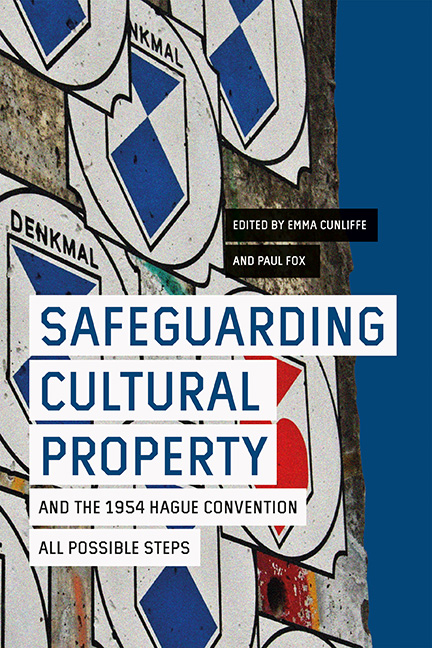Book contents
- Frontmatter
- Contents
- List of Illustrations
- List of Contributors
- Plate Section
- Acknowledgements
- List of Abbreviations
- Preface: The Blue Shield and the Protection of the World's Cultural Property – Preparing in Peace for Conflict
- Part I Safeguarding – Reassessing the Field
- Part II Historical Perspectives
- Part III Current Issues in Legal Implementation
- Part IV The Hague Convention in Practice Today: Tools and Approaches
- Appendix 1 The Hague Convention for the Protection of Cultural Property in the Event of Armed Conflict with Regulations for the Execution of the Convention 1954
- Appendix 2 Regulations for the Execution of the Convention for the Protection of Cultural Property in the Event of Armed Conflict
- Appendix 3 Resolutions of the 1954 Hague Conference
- Appendix 4 Second Protocol to the Hague Convention of 1954 for the Protection of Cultural Property in the Event of Armed Conflict 1999
- Appendix 5 Additional Protocols (1977) to the Geneva Conventions (1949) (Extracts)
- Index
- HERITAGE MATTERS
8 - The Safeguarding Measures of the 1954 Hague Convention from a Risk Management Approach
Published online by Cambridge University Press: 26 May 2022
- Frontmatter
- Contents
- List of Illustrations
- List of Contributors
- Plate Section
- Acknowledgements
- List of Abbreviations
- Preface: The Blue Shield and the Protection of the World's Cultural Property – Preparing in Peace for Conflict
- Part I Safeguarding – Reassessing the Field
- Part II Historical Perspectives
- Part III Current Issues in Legal Implementation
- Part IV The Hague Convention in Practice Today: Tools and Approaches
- Appendix 1 The Hague Convention for the Protection of Cultural Property in the Event of Armed Conflict with Regulations for the Execution of the Convention 1954
- Appendix 2 Regulations for the Execution of the Convention for the Protection of Cultural Property in the Event of Armed Conflict
- Appendix 3 Resolutions of the 1954 Hague Conference
- Appendix 4 Second Protocol to the Hague Convention of 1954 for the Protection of Cultural Property in the Event of Armed Conflict 1999
- Appendix 5 Additional Protocols (1977) to the Geneva Conventions (1949) (Extracts)
- Index
- HERITAGE MATTERS
Summary
Recent conflicts have led to severe damage and destruction of cultural property. The proclamations of the international heritage community, championed by UNESCO, have been ineffective in either deterring it or mitigating its impact. This has resulted in the violation of peoples’ human right to access their cultural heritage and has posed a threat to the safety of those who have attempted to safeguard it, and prevent looting (Mulder & Trein 2018; Amos & Meuse 2015). In addition, the impact of armed conflict on people's intangible heritage, meaning their values, traditions, and beliefs, should not be forgotten despite it being more difficult to visualise or quantify. However, damage to, and destruction of, cultural property can be prevented even when conflicts develop rapidly. In accordance with the tenets of the 1954 Hague Convention for the Protection of Cultural Property in the Event of Armed Conflict (‘the Convention’) and its protocols (collectively the Hague Convention) – the cornerstone international treaty protecting cultural property of importance to all the peoples of a state party – the key is to establish effective safeguarding measures for cultural property in advance – in peacetime – and to activate the risk management plan they represent by resolute leadership at state party level. High Contracting Parties (HCPs) are to protect such cultural property from a foundation of ‘national and international measures’ to be organised ‘in time of peace’ (Convention, Preamble).
Working out of what is essentially a risk management approach, Article 3 of the Convention urges High Contracting Parties (HCPs) to take all the necessary steps to protect their cultural property ‘as considered appropriate’ in light of the ‘foreseeable effects of an armed conflict’. The same principle is expanded in Article 5 of the 1999 Second Protocol and the Guidelines for its implementation, by listing some examples of good practice states may wish to adopt. The broad thrust of safeguarding activity proposed by the Convention is the prior preparation of protective measures that enhance the security of cultural property, understood as measures that enhance the protection of cultural property, since those responsible for delivering security must be prepared to ‘respond to the worst case when it occurs’ (Linston et al 1993).
- Type
- Chapter
- Information
- Safeguarding Cultural Property and the 1954 Hague ConventionAll Possible Steps, pp. 137 - 150Publisher: Boydell & BrewerPrint publication year: 2022
- 1
- Cited by



